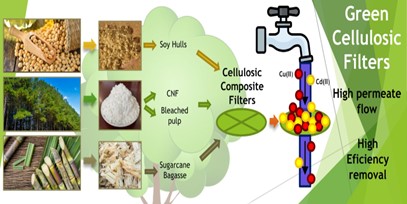Development of Agrowaste and Cellulose-based Composite Filters and Their Application in Fast Removal of Metallic Cations from Water

- Agrowaste,
- Cellulose Nanofibrils,
- Cellulosic-Composite Filters,
- Filtration,
- Metallic Cations
- Water Purification ...More
Copyright (c) 2024 Orbital: The Electronic Journal of Chemistry

This work is licensed under a Creative Commons Attribution-NonCommercial-NoDerivatives 4.0 International License.
Abstract
Low-cost lignocellulosic filters were made from soybean hulls (SH), sugarcane bagasse fibers (SBF), cellulose nanofibers (CNF), and Kraft-bleached pulp (BP) as renewable feedstocks and applied in Cu (II) and Cd (II) removal from aqueous medium. Filtration was performed with a vacuum pump; filtration times ranged from 3 to 1200 seconds. For the same filter, the best permeate flow was 13,333 L.h.m-2 for both cations. The best Cd (II) removal (77.2 %) was achieved within 7 seconds at a permeate flow of 5,714 L.h.m-2. The same filter was also the best at removing Cu (II) (46.5 %), which was achieved within 7 seconds at a permeate flow of 5,714 L.h.m-2, as well. This short time evidenced that a long contact time is not needed to achieve higher removal. The best filter was made of BP, CNF, and SH. The presence of SBF and SH increased the contact angle and decreased the solid free energy surface. By FTIR-ATR it was possible to verify with which groups present in the chemical structures of the filter components the Cd (II) and Cu (II) cations interacted best. These results demonstrate the potential use of lignocellulosic biomass for producing composites aimed at water decontamination.





